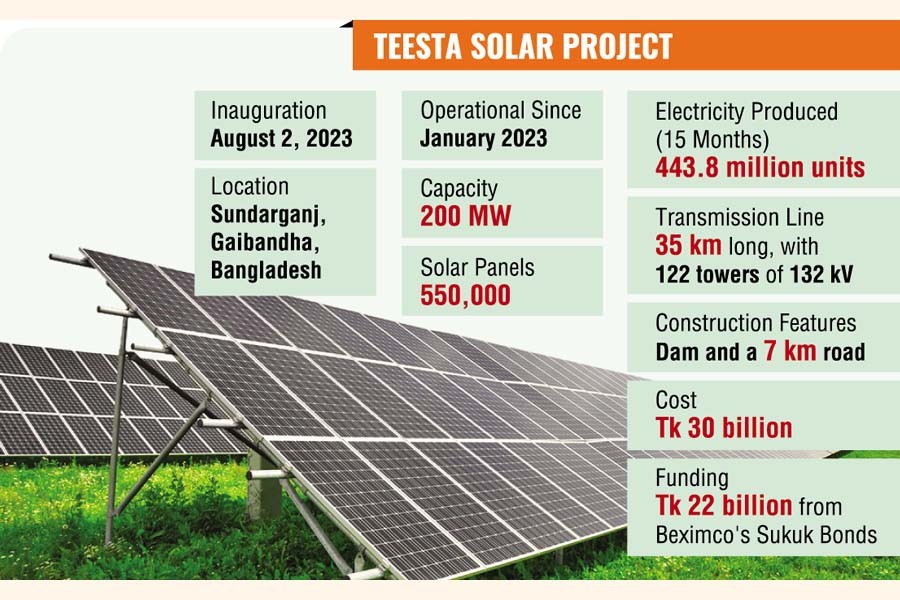Beximco's Teesta Solar powers up nat'l grid with 443.8 million units

SAJIBUR RAHMAN, back from GAIBANDHA
Published :
Updated :

Bangladesh's largest solar power facility Teesta Solar Ltd has transmitted around 443.8 million units of electricity to the national grid in the past 15 months.
The 200-megawatt (MW) plant, spanning 650 acres on the banks of Teesta River in Gaibandha's Sundarganj upazila, was officially inaugurated by Prime Minister Sheikh Hasina on August 2 last year.
During a recent visit to the site, it was found that Teesta Solar Ltd, a subsidiary of Beximco, installed around 550,000 solar panels.
Unlike conventional power plants that rely on gas, coal, or fossil fuels, the plant generates electricity without requiring fuel or incurring raw material costs -- a capability it is expected to maintain until 2043.
To connect the plant to the national grid, a 35 km power transmission line with 122 towers was constructed. The line operates at 132 kilovolts and stretches from the plant to Rangpur.
To safeguard the plant against natural disasters like floods and river erosion, a dam and a seven-kilometre road was constructed, which also benefits the local community now.
The project's total cost exceeded Tk 30 billion, with Tk 22 billion financed through Beximco's Sukuk Bonds. This initiative represents a significant step for Bangladesh in generating cleaner electricity and promoting environmental responsibility.
A study suggests that adding 2,000 MW of rooftop solar capacity could help the Bangladesh Power Development Board (BPDB) save between Tk 52.3 billion to Tk 110.32 billion per year by reducing reliance on expensive power generation and input purchases.
Engineer Md Tashikul Alam, who manages strategic planning and government affairs at Teesta Solar Ltd, said, "Around 65 per cent of our technology and equipment are imported from China. The remaining 35 per cent comes from India and other countries, including those in Europe."
He said it is possible to explore cultivating suitable agricultural products, such as nuts, underneath the solar panels.
Gautam Das, in-charge of projects at Beximco Power Company Limited, explained the advantages of solar power projects in Bangladesh compared to traditional options that rely on heavy fuel oil (HFO), coal or gas.
"Solar power is cheaper to maintain, more efficient in the long term and doesn't pollute the environment," Mr Das said.
He commented that as more solar projects are built, economies of scale will bring down costs.
However, building solar projects in Bangladesh still remains expensive compared to countries like India, according to him, due mainly to logistical and infrastructure issues.
Shafiqul Alam, lead analyst at the Institute for Energy Economics and Financial Analysis (IEEFA), said Teesta Solar Ltd accounts for roughly 50 per cent of the country's total installed utility-scale solar capacity.
"Green sukuk was used to finance the solar project, marking the first such instance in the clean energy sector," Mr Alam said. "This paves the way for renewable energy project investors to utilise similar instruments, such as green bonds, to mobilise private funds."
He added that such instruments have the capacity to streamline renewable energy project implementation and strengthen local entrepreneurship in the coming years.
According to IEEFA lead analyst, green sukuk can also be a viable option when securing international investors for independent power producer (IPP)-based renewable energy projects proves challenging.
The use of proceeds from green sukuk in this project is innovative, being the first case in Bangladesh, commented Mr Alam. "This success story may encourage other project developers to consider green sukuk as a financing option in the future."
sajibur@gmail.com


 For all latest news, follow The Financial Express Google News channel.
For all latest news, follow The Financial Express Google News channel.